Poverty, HIV/AIDS and Development
VerifiedAdded on 2023/06/03
|6
|1824
|83
AI Summary
This essay discusses various strategies for getting the maximum advantages of existing International Aids funding for HIV/AIDS in Sub-Saharan Africa, Malawi. It includes the contribution of local NGOs, domestic financial support, and innovative funding mechanisms.
Contribute Materials
Your contribution can guide someone’s learning journey. Share your
documents today.
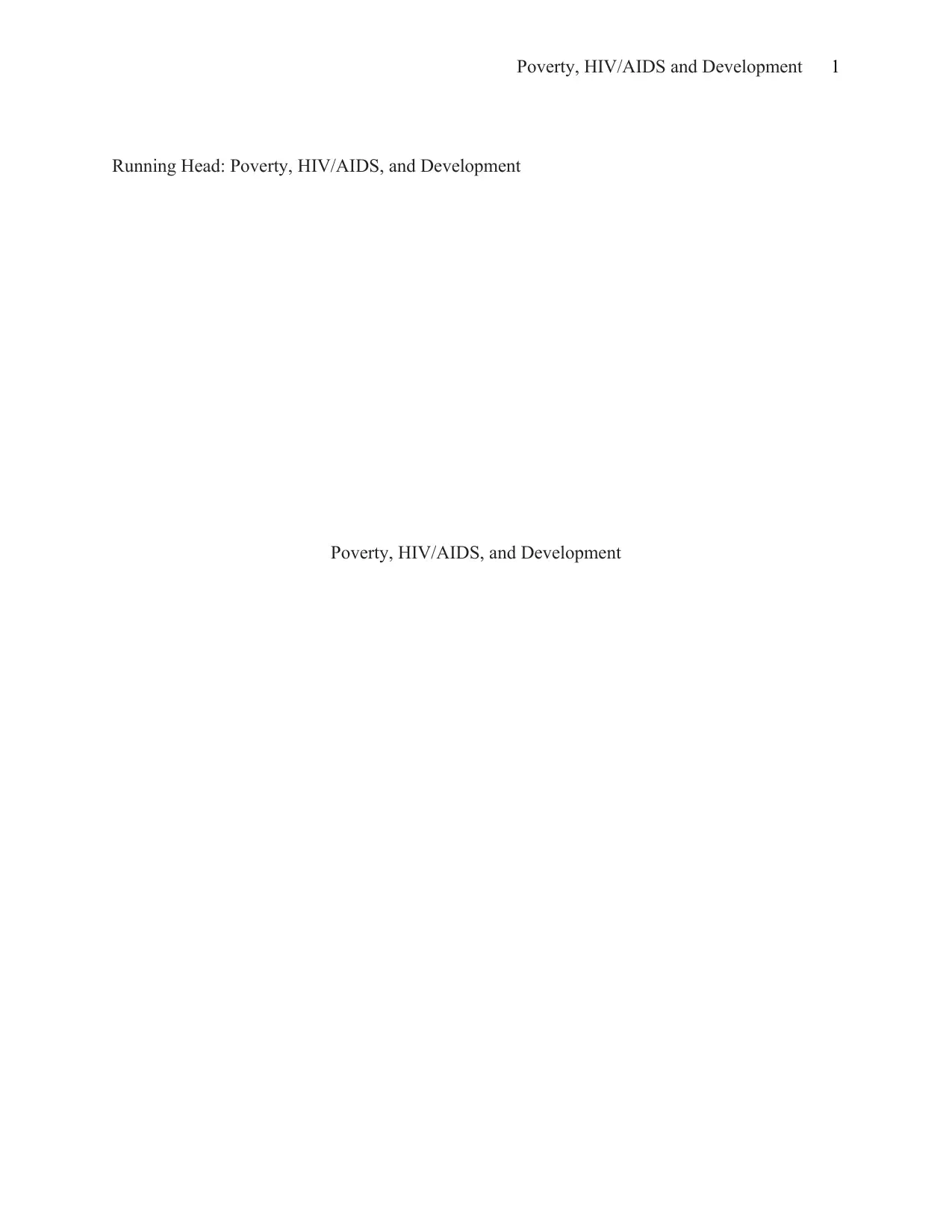
Poverty, HIV/AIDS and Development 1
Running Head: Poverty, HIV/AIDS, and Development
Poverty, HIV/AIDS, and Development
Running Head: Poverty, HIV/AIDS, and Development
Poverty, HIV/AIDS, and Development
Secure Best Marks with AI Grader
Need help grading? Try our AI Grader for instant feedback on your assignments.
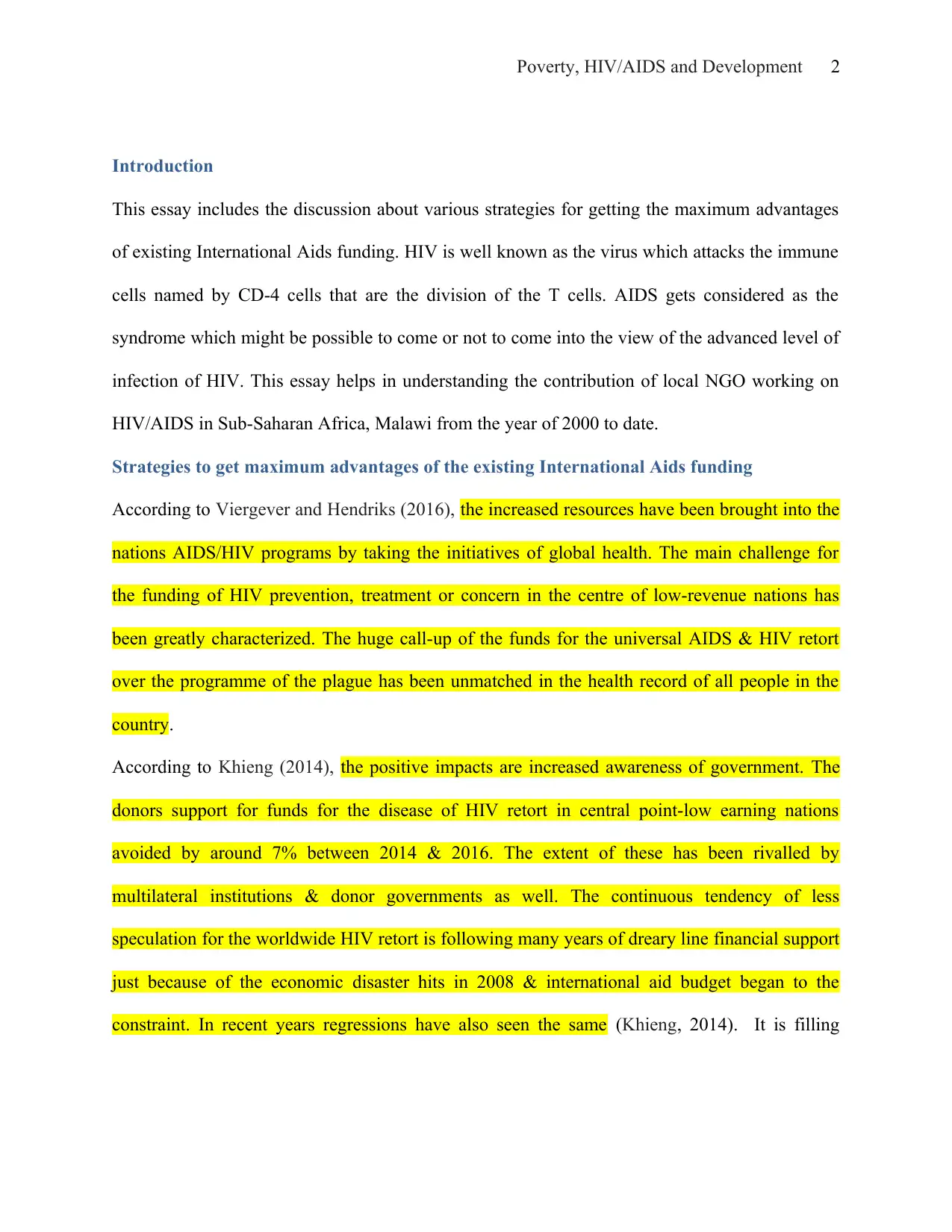
Poverty, HIV/AIDS and Development 2
Introduction
This essay includes the discussion about various strategies for getting the maximum advantages
of existing International Aids funding. HIV is well known as the virus which attacks the immune
cells named by CD-4 cells that are the division of the T cells. AIDS gets considered as the
syndrome which might be possible to come or not to come into the view of the advanced level of
infection of HIV. This essay helps in understanding the contribution of local NGO working on
HIV/AIDS in Sub-Saharan Africa, Malawi from the year of 2000 to date.
Strategies to get maximum advantages of the existing International Aids funding
According to Viergever and Hendriks (2016), the increased resources have been brought into the
nations AIDS/HIV programs by taking the initiatives of global health. The main challenge for
the funding of HIV prevention, treatment or concern in the centre of low-revenue nations has
been greatly characterized. The huge call-up of the funds for the universal AIDS & HIV retort
over the programme of the plague has been unmatched in the health record of all people in the
country.
According to Khieng (2014), the positive impacts are increased awareness of government. The
donors support for funds for the disease of HIV retort in central point-low earning nations
avoided by around 7% between 2014 & 2016. The extent of these has been rivalled by
multilateral institutions & donor governments as well. The continuous tendency of less
speculation for the worldwide HIV retort is following many years of dreary line financial support
just because of the economic disaster hits in 2008 & international aid budget began to the
constraint. In recent years regressions have also seen the same (Khieng, 2014). It is filling
Introduction
This essay includes the discussion about various strategies for getting the maximum advantages
of existing International Aids funding. HIV is well known as the virus which attacks the immune
cells named by CD-4 cells that are the division of the T cells. AIDS gets considered as the
syndrome which might be possible to come or not to come into the view of the advanced level of
infection of HIV. This essay helps in understanding the contribution of local NGO working on
HIV/AIDS in Sub-Saharan Africa, Malawi from the year of 2000 to date.
Strategies to get maximum advantages of the existing International Aids funding
According to Viergever and Hendriks (2016), the increased resources have been brought into the
nations AIDS/HIV programs by taking the initiatives of global health. The main challenge for
the funding of HIV prevention, treatment or concern in the centre of low-revenue nations has
been greatly characterized. The huge call-up of the funds for the universal AIDS & HIV retort
over the programme of the plague has been unmatched in the health record of all people in the
country.
According to Khieng (2014), the positive impacts are increased awareness of government. The
donors support for funds for the disease of HIV retort in central point-low earning nations
avoided by around 7% between 2014 & 2016. The extent of these has been rivalled by
multilateral institutions & donor governments as well. The continuous tendency of less
speculation for the worldwide HIV retort is following many years of dreary line financial support
just because of the economic disaster hits in 2008 & international aid budget began to the
constraint. In recent years regressions have also seen the same (Khieng, 2014). It is filling
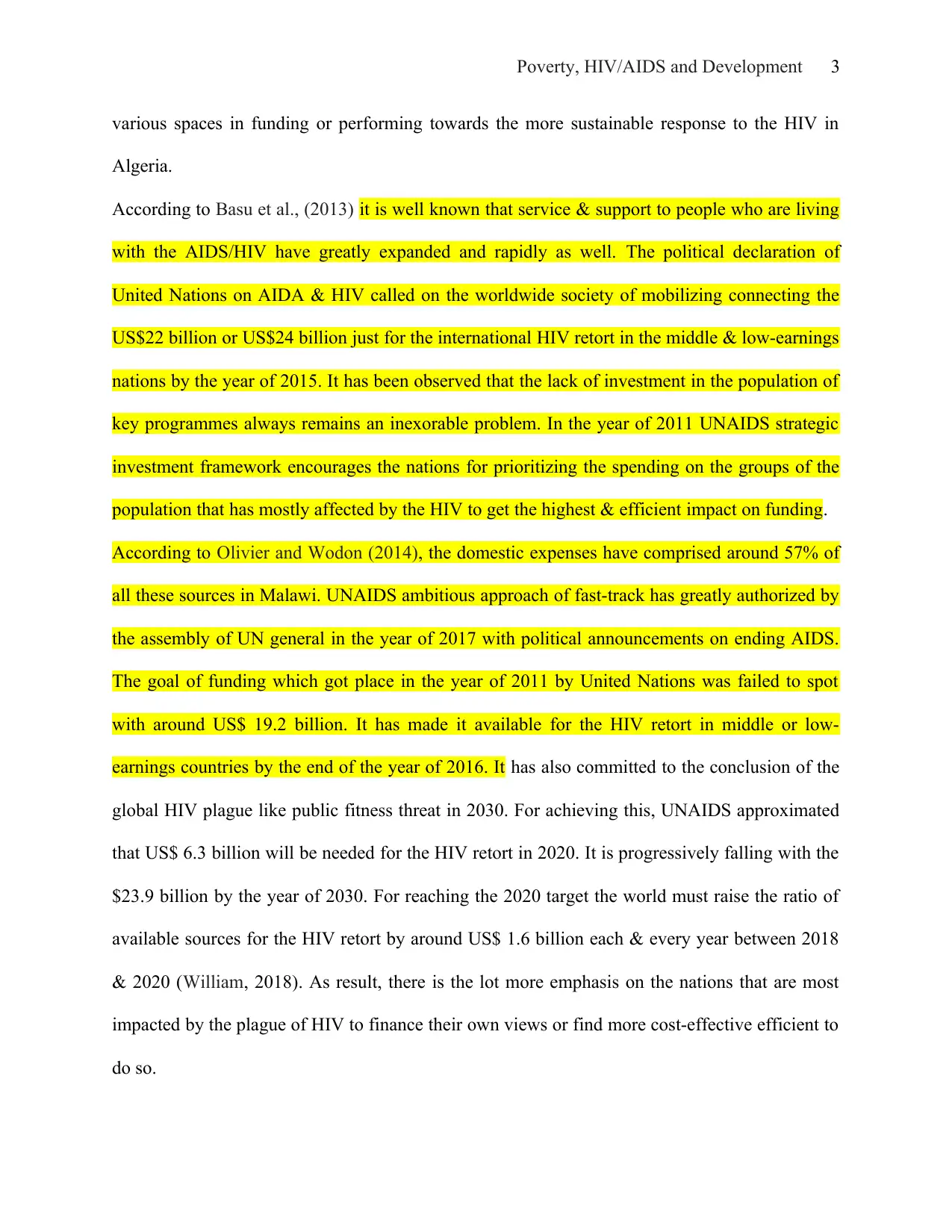
Poverty, HIV/AIDS and Development 3
various spaces in funding or performing towards the more sustainable response to the HIV in
Algeria.
According to Basu et al., (2013) it is well known that service & support to people who are living
with the AIDS/HIV have greatly expanded and rapidly as well. The political declaration of
United Nations on AIDA & HIV called on the worldwide society of mobilizing connecting the
US$22 billion or US$24 billion just for the international HIV retort in the middle & low-earnings
nations by the year of 2015. It has been observed that the lack of investment in the population of
key programmes always remains an inexorable problem. In the year of 2011 UNAIDS strategic
investment framework encourages the nations for prioritizing the spending on the groups of the
population that has mostly affected by the HIV to get the highest & efficient impact on funding.
According to Olivier and Wodon (2014), the domestic expenses have comprised around 57% of
all these sources in Malawi. UNAIDS ambitious approach of fast-track has greatly authorized by
the assembly of UN general in the year of 2017 with political announcements on ending AIDS.
The goal of funding which got place in the year of 2011 by United Nations was failed to spot
with around US$ 19.2 billion. It has made it available for the HIV retort in middle or low-
earnings countries by the end of the year of 2016. It has also committed to the conclusion of the
global HIV plague like public fitness threat in 2030. For achieving this, UNAIDS approximated
that US$ 6.3 billion will be needed for the HIV retort in 2020. It is progressively falling with the
$23.9 billion by the year of 2030. For reaching the 2020 target the world must raise the ratio of
available sources for the HIV retort by around US$ 1.6 billion each & every year between 2018
& 2020 (William, 2018). As result, there is the lot more emphasis on the nations that are most
impacted by the plague of HIV to finance their own views or find more cost-effective efficient to
do so.
various spaces in funding or performing towards the more sustainable response to the HIV in
Algeria.
According to Basu et al., (2013) it is well known that service & support to people who are living
with the AIDS/HIV have greatly expanded and rapidly as well. The political declaration of
United Nations on AIDA & HIV called on the worldwide society of mobilizing connecting the
US$22 billion or US$24 billion just for the international HIV retort in the middle & low-earnings
nations by the year of 2015. It has been observed that the lack of investment in the population of
key programmes always remains an inexorable problem. In the year of 2011 UNAIDS strategic
investment framework encourages the nations for prioritizing the spending on the groups of the
population that has mostly affected by the HIV to get the highest & efficient impact on funding.
According to Olivier and Wodon (2014), the domestic expenses have comprised around 57% of
all these sources in Malawi. UNAIDS ambitious approach of fast-track has greatly authorized by
the assembly of UN general in the year of 2017 with political announcements on ending AIDS.
The goal of funding which got place in the year of 2011 by United Nations was failed to spot
with around US$ 19.2 billion. It has made it available for the HIV retort in middle or low-
earnings countries by the end of the year of 2016. It has also committed to the conclusion of the
global HIV plague like public fitness threat in 2030. For achieving this, UNAIDS approximated
that US$ 6.3 billion will be needed for the HIV retort in 2020. It is progressively falling with the
$23.9 billion by the year of 2030. For reaching the 2020 target the world must raise the ratio of
available sources for the HIV retort by around US$ 1.6 billion each & every year between 2018
& 2020 (William, 2018). As result, there is the lot more emphasis on the nations that are most
impacted by the plague of HIV to finance their own views or find more cost-effective efficient to
do so.
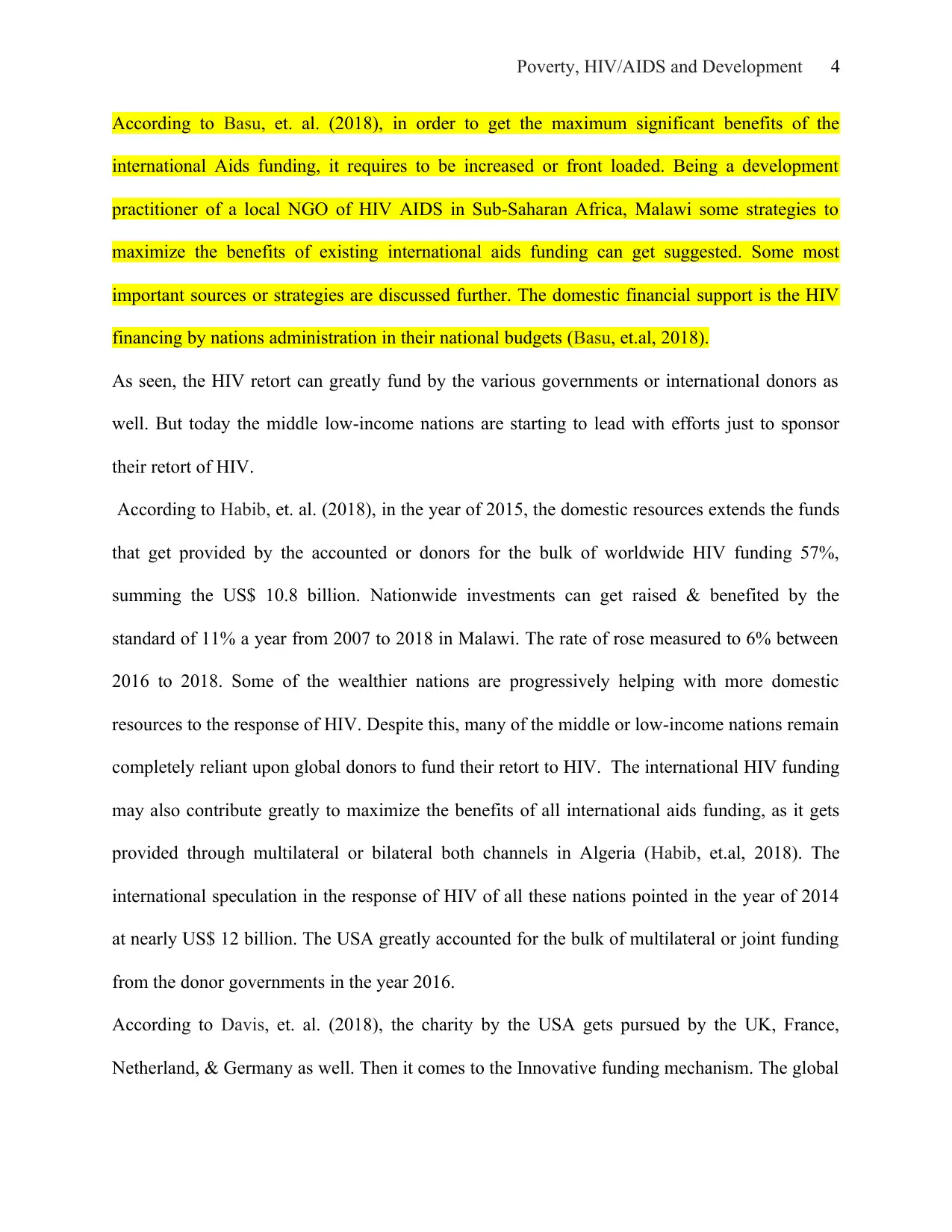
Poverty, HIV/AIDS and Development 4
According to Basu, et. al. (2018), in order to get the maximum significant benefits of the
international Aids funding, it requires to be increased or front loaded. Being a development
practitioner of a local NGO of HIV AIDS in Sub-Saharan Africa, Malawi some strategies to
maximize the benefits of existing international aids funding can get suggested. Some most
important sources or strategies are discussed further. The domestic financial support is the HIV
financing by nations administration in their national budgets (Basu, et.al, 2018).
As seen, the HIV retort can greatly fund by the various governments or international donors as
well. But today the middle low-income nations are starting to lead with efforts just to sponsor
their retort of HIV.
According to Habib, et. al. (2018), in the year of 2015, the domestic resources extends the funds
that get provided by the accounted or donors for the bulk of worldwide HIV funding 57%,
summing the US$ 10.8 billion. Nationwide investments can get raised & benefited by the
standard of 11% a year from 2007 to 2018 in Malawi. The rate of rose measured to 6% between
2016 to 2018. Some of the wealthier nations are progressively helping with more domestic
resources to the response of HIV. Despite this, many of the middle or low-income nations remain
completely reliant upon global donors to fund their retort to HIV. The international HIV funding
may also contribute greatly to maximize the benefits of all international aids funding, as it gets
provided through multilateral or bilateral both channels in Algeria (Habib, et.al, 2018). The
international speculation in the response of HIV of all these nations pointed in the year of 2014
at nearly US$ 12 billion. The USA greatly accounted for the bulk of multilateral or joint funding
from the donor governments in the year 2016.
According to Davis, et. al. (2018), the charity by the USA gets pursued by the UK, France,
Netherland, & Germany as well. Then it comes to the Innovative funding mechanism. The global
According to Basu, et. al. (2018), in order to get the maximum significant benefits of the
international Aids funding, it requires to be increased or front loaded. Being a development
practitioner of a local NGO of HIV AIDS in Sub-Saharan Africa, Malawi some strategies to
maximize the benefits of existing international aids funding can get suggested. Some most
important sources or strategies are discussed further. The domestic financial support is the HIV
financing by nations administration in their national budgets (Basu, et.al, 2018).
As seen, the HIV retort can greatly fund by the various governments or international donors as
well. But today the middle low-income nations are starting to lead with efforts just to sponsor
their retort of HIV.
According to Habib, et. al. (2018), in the year of 2015, the domestic resources extends the funds
that get provided by the accounted or donors for the bulk of worldwide HIV funding 57%,
summing the US$ 10.8 billion. Nationwide investments can get raised & benefited by the
standard of 11% a year from 2007 to 2018 in Malawi. The rate of rose measured to 6% between
2016 to 2018. Some of the wealthier nations are progressively helping with more domestic
resources to the response of HIV. Despite this, many of the middle or low-income nations remain
completely reliant upon global donors to fund their retort to HIV. The international HIV funding
may also contribute greatly to maximize the benefits of all international aids funding, as it gets
provided through multilateral or bilateral both channels in Algeria (Habib, et.al, 2018). The
international speculation in the response of HIV of all these nations pointed in the year of 2014
at nearly US$ 12 billion. The USA greatly accounted for the bulk of multilateral or joint funding
from the donor governments in the year 2016.
According to Davis, et. al. (2018), the charity by the USA gets pursued by the UK, France,
Netherland, & Germany as well. Then it comes to the Innovative funding mechanism. The global
Secure Best Marks with AI Grader
Need help grading? Try our AI Grader for instant feedback on your assignments.
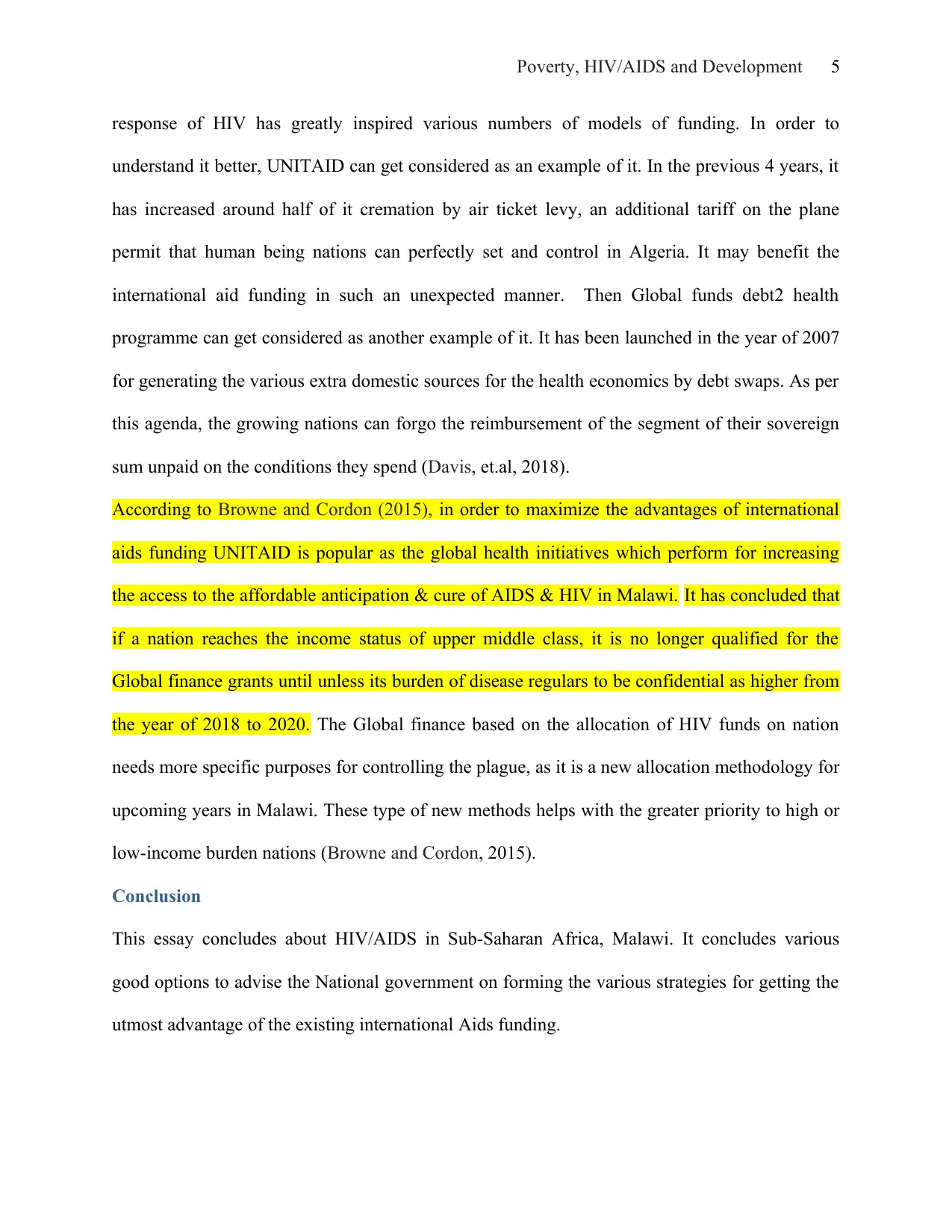
Poverty, HIV/AIDS and Development 5
response of HIV has greatly inspired various numbers of models of funding. In order to
understand it better, UNITAID can get considered as an example of it. In the previous 4 years, it
has increased around half of it cremation by air ticket levy, an additional tariff on the plane
permit that human being nations can perfectly set and control in Algeria. It may benefit the
international aid funding in such an unexpected manner. Then Global funds debt2 health
programme can get considered as another example of it. It has been launched in the year of 2007
for generating the various extra domestic sources for the health economics by debt swaps. As per
this agenda, the growing nations can forgo the reimbursement of the segment of their sovereign
sum unpaid on the conditions they spend (Davis, et.al, 2018).
According to Browne and Cordon (2015), in order to maximize the advantages of international
aids funding UNITAID is popular as the global health initiatives which perform for increasing
the access to the affordable anticipation & cure of AIDS & HIV in Malawi. It has concluded that
if a nation reaches the income status of upper middle class, it is no longer qualified for the
Global finance grants until unless its burden of disease regulars to be confidential as higher from
the year of 2018 to 2020. The Global finance based on the allocation of HIV funds on nation
needs more specific purposes for controlling the plague, as it is a new allocation methodology for
upcoming years in Malawi. These type of new methods helps with the greater priority to high or
low-income burden nations (Browne and Cordon, 2015).
Conclusion
This essay concludes about HIV/AIDS in Sub-Saharan Africa, Malawi. It concludes various
good options to advise the National government on forming the various strategies for getting the
utmost advantage of the existing international Aids funding.
response of HIV has greatly inspired various numbers of models of funding. In order to
understand it better, UNITAID can get considered as an example of it. In the previous 4 years, it
has increased around half of it cremation by air ticket levy, an additional tariff on the plane
permit that human being nations can perfectly set and control in Algeria. It may benefit the
international aid funding in such an unexpected manner. Then Global funds debt2 health
programme can get considered as another example of it. It has been launched in the year of 2007
for generating the various extra domestic sources for the health economics by debt swaps. As per
this agenda, the growing nations can forgo the reimbursement of the segment of their sovereign
sum unpaid on the conditions they spend (Davis, et.al, 2018).
According to Browne and Cordon (2015), in order to maximize the advantages of international
aids funding UNITAID is popular as the global health initiatives which perform for increasing
the access to the affordable anticipation & cure of AIDS & HIV in Malawi. It has concluded that
if a nation reaches the income status of upper middle class, it is no longer qualified for the
Global finance grants until unless its burden of disease regulars to be confidential as higher from
the year of 2018 to 2020. The Global finance based on the allocation of HIV funds on nation
needs more specific purposes for controlling the plague, as it is a new allocation methodology for
upcoming years in Malawi. These type of new methods helps with the greater priority to high or
low-income burden nations (Browne and Cordon, 2015).
Conclusion
This essay concludes about HIV/AIDS in Sub-Saharan Africa, Malawi. It concludes various
good options to advise the National government on forming the various strategies for getting the
utmost advantage of the existing international Aids funding.
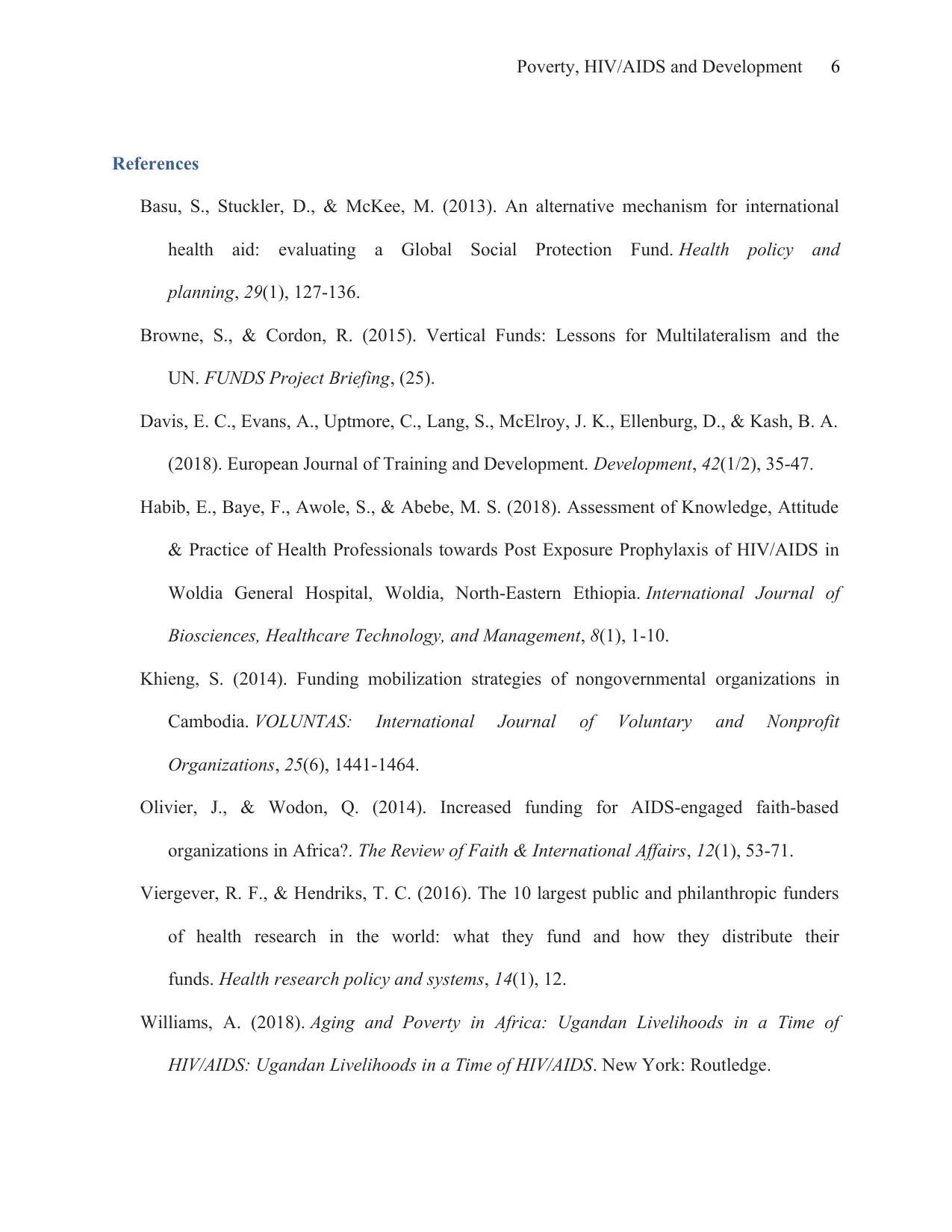
Poverty, HIV/AIDS and Development 6
References
Basu, S., Stuckler, D., & McKee, M. (2013). An alternative mechanism for international
health aid: evaluating a Global Social Protection Fund. Health policy and
planning, 29(1), 127-136.
Browne, S., & Cordon, R. (2015). Vertical Funds: Lessons for Multilateralism and the
UN. FUNDS Project Briefing, (25).
Davis, E. C., Evans, A., Uptmore, C., Lang, S., McElroy, J. K., Ellenburg, D., & Kash, B. A.
(2018). European Journal of Training and Development. Development, 42(1/2), 35-47.
Habib, E., Baye, F., Awole, S., & Abebe, M. S. (2018). Assessment of Knowledge, Attitude
& Practice of Health Professionals towards Post Exposure Prophylaxis of HIV/AIDS in
Woldia General Hospital, Woldia, North-Eastern Ethiopia. International Journal of
Biosciences, Healthcare Technology, and Management, 8(1), 1-10.
Khieng, S. (2014). Funding mobilization strategies of nongovernmental organizations in
Cambodia. VOLUNTAS: International Journal of Voluntary and Nonprofit
Organizations, 25(6), 1441-1464.
Olivier, J., & Wodon, Q. (2014). Increased funding for AIDS-engaged faith-based
organizations in Africa?. The Review of Faith & International Affairs, 12(1), 53-71.
Viergever, R. F., & Hendriks, T. C. (2016). The 10 largest public and philanthropic funders
of health research in the world: what they fund and how they distribute their
funds. Health research policy and systems, 14(1), 12.
Williams, A. (2018). Aging and Poverty in Africa: Ugandan Livelihoods in a Time of
HIV/AIDS: Ugandan Livelihoods in a Time of HIV/AIDS. New York: Routledge.
References
Basu, S., Stuckler, D., & McKee, M. (2013). An alternative mechanism for international
health aid: evaluating a Global Social Protection Fund. Health policy and
planning, 29(1), 127-136.
Browne, S., & Cordon, R. (2015). Vertical Funds: Lessons for Multilateralism and the
UN. FUNDS Project Briefing, (25).
Davis, E. C., Evans, A., Uptmore, C., Lang, S., McElroy, J. K., Ellenburg, D., & Kash, B. A.
(2018). European Journal of Training and Development. Development, 42(1/2), 35-47.
Habib, E., Baye, F., Awole, S., & Abebe, M. S. (2018). Assessment of Knowledge, Attitude
& Practice of Health Professionals towards Post Exposure Prophylaxis of HIV/AIDS in
Woldia General Hospital, Woldia, North-Eastern Ethiopia. International Journal of
Biosciences, Healthcare Technology, and Management, 8(1), 1-10.
Khieng, S. (2014). Funding mobilization strategies of nongovernmental organizations in
Cambodia. VOLUNTAS: International Journal of Voluntary and Nonprofit
Organizations, 25(6), 1441-1464.
Olivier, J., & Wodon, Q. (2014). Increased funding for AIDS-engaged faith-based
organizations in Africa?. The Review of Faith & International Affairs, 12(1), 53-71.
Viergever, R. F., & Hendriks, T. C. (2016). The 10 largest public and philanthropic funders
of health research in the world: what they fund and how they distribute their
funds. Health research policy and systems, 14(1), 12.
Williams, A. (2018). Aging and Poverty in Africa: Ugandan Livelihoods in a Time of
HIV/AIDS: Ugandan Livelihoods in a Time of HIV/AIDS. New York: Routledge.
1 out of 6
Related Documents
Your All-in-One AI-Powered Toolkit for Academic Success.
+13062052269
info@desklib.com
Available 24*7 on WhatsApp / Email
![[object Object]](/_next/static/media/star-bottom.7253800d.svg)
Unlock your academic potential
© 2024 | Zucol Services PVT LTD | All rights reserved.





